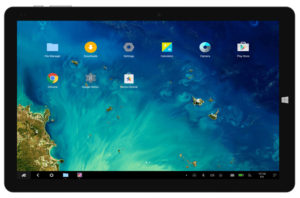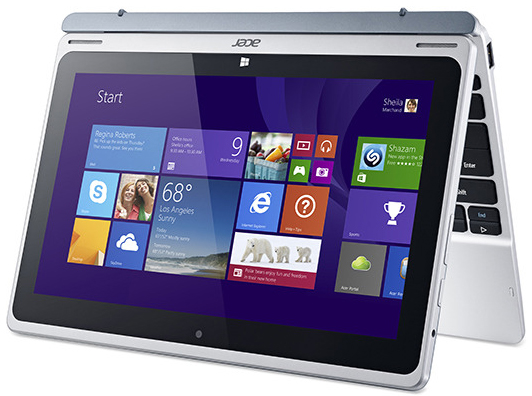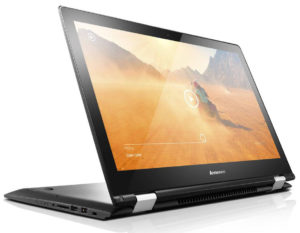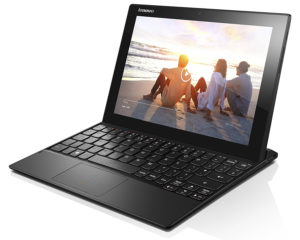CHUWI Hi10 Pro review – a great budget tablet with two operating systems
 Chuwi Hi10 Pro is a budget mobile device which combines a stylish and simple aluminum body with a capacitive 10.1” IPS display and Full HD resolution. The tablet provides the ability to work with two operating systems – Windows 10 Home and Android 5.1 Lollipop using the Remix 2.0 UI.
Chuwi Hi10 Pro is a budget mobile device which combines a stylish and simple aluminum body with a capacitive 10.1” IPS display and Full HD resolution. The tablet provides the ability to work with two operating systems – Windows 10 Home and Android 5.1 Lollipop using the Remix 2.0 UI.
The device is equipped with a quad-core Intel X5-Z8350 CPU, features 4GB RAM running at 1066 MHz frequency and has 64GB integrated eMMC flash memory for data storage.
The Chuwi Hi10 Pro can exchange data wirelessly via Bluetooth 4.0 and a WLAN module (802.11b/g/n). LTE as well as GPS and NFC (Near Field Communication) are not available. Additionally, the range of the Wi-Fi radio module is acceptable for everyday use and the signal remains stable at all times.
You can check the current price and availability of this device HERE. And if you wish to check the set with a keyboard docking station, feel free to click HERE.
Contents
Retail package
The tablet came to our office well packed in a box. Its set offers an AC adapter BLT-XC0520 model supplying the tablet with 5V of voltage and providing a 3A current. Also, the power cord has a USB 3.0 Type A plug on one side and USB 3.0 Type C one on the other. In the package we also found all the usual user manuals as well as the tablet itself.
Design and construction
As we mentioned above, the tablet body is entirely made of aluminum giving it a very good appearance. The lid meets the front body seamlessly, there are no discrepancies to be found. Chuwi Hi10 Pro’s edges are rounded and the device has a high-quality feeling. On the outside, the back lid has a matte silver finish which is fingerprint-proof.
Due to the CPU’s low energy consumption the cooling of the tablet is passive and there are no available cooling vents. A heat-conductive tape is glued on top of the passive cooling leaning firmly on the aluminum lid and thus it turns into a radiator that further dissipates CPU heat.
We can see that the power supply is realized through two parallelly connected batteries, while the touchscreen driver can be noticed in the upper left corner.
The tablet features 1x Micro USB 2.0, 1x USB 3.0 Type C, 1x Micro HDMI, SD card reader for Micro SD cards with maximum size of 128 GB, 3.5 mm audio jack. In the lower left part of the body you can see the tablet’s speaker. On the left side, you will find the keyboard connectors which also plays the role of a docking station. On the right side, you can find the Power and Volume buttons.
Additionally, the tablet can be equipped with an external keyboard and stylus that are not included in the set but are purchased additionally. In the external keyboard there is an additional battery increasing the autonomous work of the tablet.

Display quality
Chuwi Hi10 Pro’s display features a WUXGA (Widescreen Ultra Extended Graphics Array) panel with an IPS matrix. Its diagonal is 10.1 inches (25.65 cm) and the resolution is 1920 х 1200 pixels. In addition, the screen has 16:10 aspect ratio, 224 ppi pixel density and 0.113 х 0.113 mm pixel pitch. It can be considered as “Retina” when viewed from a distance equal to or greater than 68 cm (at this point the human eye stops differentiating individual pixels).

Viewing angles are comfortable. We offer images at an angle of 45 ° to evaluate image quality.

We were able to record a very high maximum brightness of 508 cd/m2 in the center of the screen and 504 cd/m2 as average across the surface with only 2% maximum deviation. The color temperature (Correlated Color Temperature) at maximum brightness on white screen is 7940K, which is considerably colder than the standard 6500K. As we go along the grayscale with different brightness levels, the color temperature appears to remain at around 7950K (it can be fixed with our customized profiles).
The maximum color deviation dE2000 (compared to the center of the screen at 23% brightness and 100% RGB) is 0.9. Values above 4.0 are unwanted. This is a very important parameter, one of the first things to look at if the color accuracy of the display matters to you.
Here we should note that we find the display’s behavior similar to that of one with Content Adaptive Brightness Control (CABC) that we could not turn off. The latter may have affected the accuracy of the results.

Color reproduction
To make sure we are on the same page, we would like to give you a little introduction of the sRGB color gamut and the Adobe RGB. To start, there’s the CIE 1976 Uniform Chromaticity Diagram that represents the visible specter of colors by the human eye, giving you a better perception of the color gamut coverage and the color accuracy.
Inside the black triangle, you will see the standard color gamut (sRGB) that is being used by millions of people in HDTV and on the web. As for the Adobe RGB, this is used in professional cameras, monitors etc for printing. Basically, colors inside the black triangle are used by everyone and this is the essential part of the color quality and color accuracy of a mainstream notebook.
Still, we’ve included other color spaces like the famous DCI-P3 standard used by movie studios, as well as the digital UHD Rec.2020 standard. Rec.2020, however, is still a thing of the future and it’s difficult for today’s displays to cover that well. We’ve also included the so-called Michael Pointer gamut, or Pointer’s gamut, which represents the colors that naturally occur around us every day.
We are pleased to see that the sRGB/ITU-R BT.709 (web/HDTV standard) coverage goes as high as 90%.

Below you will see practically the same image but with the color circles representing the reference colors and the white circles being the result. You can see main and additional colors with 25%, 50%, 75% and 100% saturation inside the sRGB gamut pre and post calibration.
You can compare the results with the factory settings (on the left), and with the “Design and Gaming” profile on the right.
We tested the accuracy of the display with 24 commonly used colors like light and dark human skin, blue sky, green grass, orange etc. You can check out the Chuwi Hi10 Pro results at factory condition (on the left) and also, with the “Design and Gaming” profile (on the right).
The next figure shows how well the display is able to reproduce really dark parts of an image, which is essential when watching movies or playing games in low ambient light.
The left side of the image represents the display with stock settings, while the right one is with the “Gaming and Web Design” profile activated. On the horizontal axis, you will find the grayscale and on the vertical axis – the luminance of the display. On the two graphs below you can easily check for yourself how your display handles the darkest nuances but keep in mind that this also depends on the settings of your current display, the calibration, the viewing angle and the surrounding light conditions.

Gaming capabilities (Response time)
We test the reaction time of the pixels with the usual “black-to-white” and “white-to-black” method from 10% to 90% and reverse.
We recorded Fall Time + Rise Time = 16 ms.
The matrix is fast for its type.

PWM (Screen flickering)
Pulse-width modulation (PWM) is an easy way to control monitor brightness. When you lower the brightness, the light intensity of the backlight is not lowered, but instead turned off and on by the electronics with a frequency indistinguishable to the human eye. In these light impulses the light/no-light time ratio varies, while brightness remains unchanged, which is harmful to your eyes. You can read more about that in our dedicated article on PWM.
Chuwi Hi10 Pro’s screen doesn’t use PWM providing rest for your eyes in this respect (only negligible pulses with high (about 20kHz) frequency are reported).

Blue light emissions
Installing of our Health-Guard profile not only eliminates PWM but also reduces the harmful Blue Light emissions while keeping the colors of the screen perceptually accurate. If you’re not familiar with the Blue light, the TL;DR version is – emissions that negatively affect your eyes, skin and your whole body. You can find more information about that in our dedicated article on Blue Light.
You can see the levels of emitted blue light on the spectral power distribution (SDP) graph.
The following graph shows the spectral distribution of the light emitted on a white screen and a brightness of approximately 140 cd / m2. Its left part is with factory settings, while the right one is with our Health Guard profile.

Buy our display profiles
Since our profiles are tailored for each individual display model, this article and its respective profile package is meant for CHUWI Hi10 Pro configurations with 10.1″ WUXGA (Widescreen Ultra Extended Graphics Array) IPS Full HD screen and the tablet can be found HERE.
*Should you have problems with downloading the purchased file, try using a different browser to open the link you’ll receive via e-mail. If the download target is a .php file instead of an archive, change the file extension to .zip or contact us at [email protected].
Read more about the profiles HERE.
In addition to receiving efficient and health-friendly profiles, by buying LaptopMedia's products you also support the development of our labs, where we test devices in order to produce the most objective reviews possible.

Office Work
Office Work should be used mostly by users who spend most of the time looking at pieces of text, tables or just surfing. This profile aims to deliver better distinctness and clarity by keeping a flat gamma curve (2.20), native color temperature and perceptually accurate colors.

Design and Gaming
This profile is aimed at designers who work with colors professionally, and for games and movies as well. Design and Gaming takes display panels to their limits, making them as accurate as possible in the sRGB IEC61966-2-1 standard for Web and HDTV, at white point D65.

Health-Guard
Health-Guard eliminates the harmful Pulse-Width Modulation (PWM) and reduces the negative Blue Light which affects our eyes and body. Since it’s custom tailored for every panel, it manages to keep the colors perceptually accurate. Health-Guard simulates paper so the pressure on the eyes is greatly reduced.
Get all 3 profiles with 33% discount
Sound
Chuwi Hi10 Pro has a good sound quality. At low and high frequencies there is slight distortion.

Specs sheet
The current specs sheet refers to this particular model – configurations may differ depending on your region.
| CPU | Intel Atom x5-Z8350 (4-core, 1.44-1.92 GHz, 2MB cache) |
|---|---|
| RAM | 4GB (1x 4096MB) – LPDDR3 RAM, 1066 MHz |
| GPU | Intel HD Graphics 400 (Gen8) |
| HDD/SSD | 64GB 064G93 TOSHIBA flash storage |
| Display | 10.1-inch IPS Full HD (1920×1200) , 16:10 aspect ratio |
| Optical drive | – |
| Connectivity | Wireless N (Realtek RTL8723BS), Bluetooth 4.0 |
| Features |
|
| Battery | 6500mAh, 3.7V, Li-Polymer |
| Thickness | 9.27 mm |
| Weight | 0.565 mm |
Software
The tablet came with two pre-installed operating systems – Windows 10 Home (64-bit) and Android 5.1 Lollipop. The tests and benchmarks were conducted on the Windows 10 Home OS.
Battery
Chuwi has chosen a 6500mAh lithium-polymer battery for the Hi10 Pro, which surprises us with long hours of autonomous work. It operates at 3.7 V of voltage and charges with an adapter with a working voltage of 5V/ 3A. All tests were run using the usual settings – Wi-Fi turned on, Windows battery saving feature turned on and screen brightness set to 120 cd/m2.
Web browsing
In order to simulate real-life conditions, we used our own script for automatic web browsing through over 70 websites.

Pretty good Web browsing results – 438 minutes (7 hours and 18 minutes).
Video playback
For every test like this, we use the same video in HD.

Slightly above average result, namely – 350 minutes (5 hours and 50 minutes).
Gaming
We recently started using F1 2015’s built-in benchmark on loop in order to simulate real-life gaming.

The gaming is certainly not the strong side of this tablet but despite this the battery test in game mode is pretty high – 206 minutes (3 hours and 26 minutes).
CPU – Intel Atom X5-Z8350

Intel Atom x5-Z8350 is a very energy efficient 4-core SoC which can be found in ultra-thin laptops, convertibles or tablets. It has been launched in Q1 2016 as a part of the Cherry Trail generation. Atom x5-Z8350’s base frequency is 1.44 GHz but when needed it can be boosted up to 1.92 GHz which brings enough processing power for everyday tasks as surfing the Web, reading e-mails or working with office applications.
The x5-Z8350 is manufactured through 14 nm process and its TDP is less than 4 watts. Intel claims that its SDP (Scenario Design Power) is just 2W.
Compared to its ARM-based rivals, Atom x5-Z8350 has a performance similar to Qualcomm Snapdragon 801.
Check the prices of all notebooks equipped with Atom x5-Z8350:
http://amzn.to/2uRmOsh
Here you will find other useful information and every tablet we’ve tested with this processor: http://laptopmedia.com/processor/intel-atom-x5-z8350/
Results are from the Cinebench 20 CPU test (the higher the score, the better)
Results are from our Photoshop benchmark test (the lower the score, the better)
Results are from the Fritz chess benchmark (the higher the score, the better)
Fritz
Fritz is a chess benchmark that tests the computing capabilities of the CPU with various chess moves. Intel Atom X5-Z8350 scored 5.970 million moves per second. In comparison, one of the most powerful chess computers, Deep(er) Blue, was able to squeeze out 200 million moves per second. In 1997 Deep(er) Blue even beat the famous Garry Kasparov with 3.5 to 2.5.
GPU – Intel HD Graphics 400 (Gen8)
 Intel HD Graphics (Cherry Trail) is an integrated graphics chip in CPUs from the Cherry-Trail platform designed to be implemented in mobile devices working with Windows and Android operating systems. It is based on the Broadwell (Intel Gen8) architecture and features 12 EUs running at up to 500MHz clock speeds. The main advantage of this chip over its predecessor with the Haswell architecture is the increased number of EUs, achieved thanks to a 14nm technological manufacturing process. Being used in Windows, the chip handles everyday tasks such as web browsing or MS Office perfectly but this doesn’t apply when we are talking about elaborate software or modern games.
Intel HD Graphics (Cherry Trail) is an integrated graphics chip in CPUs from the Cherry-Trail platform designed to be implemented in mobile devices working with Windows and Android operating systems. It is based on the Broadwell (Intel Gen8) architecture and features 12 EUs running at up to 500MHz clock speeds. The main advantage of this chip over its predecessor with the Haswell architecture is the increased number of EUs, achieved thanks to a 14nm technological manufacturing process. Being used in Windows, the chip handles everyday tasks such as web browsing or MS Office perfectly but this doesn’t apply when we are talking about elaborate software or modern games.
Results are from the 3DMark: Fire Strike (Graphics) benchmark (higher the score, the better)
Results are from the Unigine Superposition benchmark (higher the score, the better)
Camera
The tablet features a front and rear video camera with 2.0 MP resolution, recording 720p HD videos. As you may guess, the quality of the front camera is enough for video conference calls. The rear camera, however, takes mediocre shots, and there is no built-in flashlight.
Verdict
To sum things up, we can say that Chuwi Hi10 Pro is one amazing tablet that can handle your everyday tasks perfectly. With its aluminum body, huge 10.1-inch display and good enough battery that can endure an average of up to 5-8 hours of autonomous work, it provides an ideal combination to meet the everyday needs of the average user.
In the display tests the color accuracy was very poor – DeltaE = 10 but our profiles managed to reduce this value to 3.5 which is an acceptable result. Our only complaint is the older version of Android OS.
You can check the current price and availability of this device HERE. And if you wish to check the set with a keyboard docking station, feel free to click HERE.
Pros
- Two operating systems
- Great battery life
- IPS screen with 90% sRGB coverage
- Good built quality
- Thin and light for a 10.1-inch tablet
- The screen doesn’t use PWM across all brightness levels
- Good wireless network
- Affordable price
Cons
- Older version of Android OS
- Low resolution in both cameras
































Do you have benchmark and display profile for Hi10 plus?
The review is much appreciated and helped me to decide which tablet was applicable for my uses. The review, being so detailed and well written, was of great benefit to me. Thanks, again, for the detailed review.
I’m looking for a motherboard for this Chuwi hi10 Pro tablet. Can you direct me to a source? Thanks.